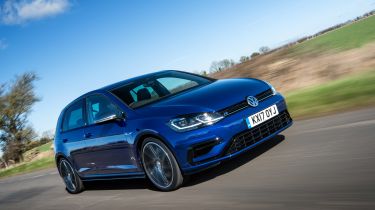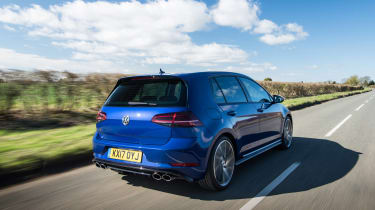Volkswagen Golf R (2013-2020) review - Engines, performance and drive
Blistering performance, agile handling and rock solid composure make the Golf R a great hot hatch

Perhaps the best thing about the Golf R is that it really makes use of all of its performance. If the front tyres slip, the 4MOTION all-wheel-drive system can send virtually all of the engine’s power to the rear end in a fraction of a second. Whereas a high-powered front-drive car such as the Renault Megane RS would be left floundering with its traction control light flickering, the Golf simply digs all four tyres into the tarmac, grips and goes.
The manual version (unfortunately now discontinued) will do 0-62mph in a mere 5.1 seconds, while the DSG model features launch control and trims that to 4.7 seconds, regardless of who’s behind the wheel.
• The best hot hatchbacks to buy now
On the road, the Golf R feels effortlessly quick, with the added reassurance of its all-wheel drive allowing you to exploit all of the available performance. There’s loads of grip, traction is excellent and, unlike front-wheel-drive rivals, you won’t find yourself troubling the traction control very often.
Yet for all its extra poise the Golf R feels very much like a GTI, with the same precise turn-in, composed body control and nicely weighted responses on the road.
No front-wheel-drive car can match it, even if it’s fitted with a limited-slip diff. If you want to have some real fun, turning off the traction control fully disengages the system. However, the Golf R is so balanced that to destabilise it you’ll need to be doing silly speeds to get the back end sliding, so that’s best left for the track. Provoke it and it’ll play, although it’s not as adjustable as the rear-drive BMW M140i.
Used - available now

2021 Skoda
Kodiaq
44,692 milesAutomaticPetrol2.0L
Cash £23,200
2023 Kia
Rio
24,181 milesManualPetrol1.2L
Cash £10,800
2023 Tesla
New Model Y
54,153 milesAutomaticElectric
Cash £22,300
2023 Land Rover
Range Rover Evoque
30,376 milesManualDiesel2.0L
Cash £20,000That pretty much sums up the Golf R's purpose – it's for people who until now didn’t think a Golf GTI was focused or fast enough. This version is just that but is still a Golf; it’s still comfortable – especially if you have the optional adaptive dampers set to Comfort
VW’s standard driver profile selection system lets you choose from Eco, Normal, Race or Individual modes, and with the optional Adaptive Chassis Control, damping is adjusted alongside throttle mapping and steering weight. We found we got the best set up for UK roads by using the Individual mode to set the throttle and steering to Race and the damping to Comfort.
Engines
Under the bonnet of the Golf R is a reworked version of the same EA 888 2.0-litre turbo that’s used in the Golf GTI. At one point the R pumped out 306bhp, which is 79bhp more than 227bhp Golf GTI, although later WLTP-compliant versions pegged this back to 296bhp. Maximum torque is 400Nm, and the car promises to sprint from 0-60mph in under five seconds.
The engine sounds the part, too. At idle there’s a bassy rumble that is purposeful but not intrusive, while the unit takes on a hard-edged growl as the revs rise.








